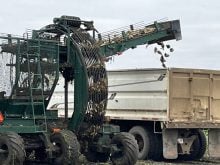Recently I attended a garden information session on xeriscape landscaping. The speaker was Patricia Hanbidge from the University of Saskatchewan. Xeriscaping is a landscape technique using drought resistant vegetation that is able to survive on rainfall and ground water once established.
- The first principle of xeriscaping is plants should be grouped according to specific water needs. Draw your present yard’s plants and structures, then add in your future plans. Create a list of the plants needed to limit impulse buying and overspending.
- The goal is to provide adequate water to the root zone of the plants. Avoid watering too little, too often. Water in the morning to reduce evaporation. New plantings should be watered frequently for the first two or three years until established.
Read Also

Accurate accounting, inventory records are important
Maintaining detailed accounting and inventory records is not just a best practice; it’s a critical component of financial health, operational efficiency and compliance with programs like AgriStability.
Mow grass less often and keep it taller to cool the soil and thus reduce the amount of water needed.
- Use organic mulches to prevent moisture escape into the atmosphere.
Dough recipes wanted
Dear TEAM : I am looking for recipes for spudnuts, beaver tails and a dough cooked on a stick over a campfire. – B.G., Islay, Alta.
Dear B.G.: The three recipes that you have requested all have special childhood memories for me of going to the fair and summer camping.
Spudnuts
41/2 teaspoons yeast 22 mL
(2 packages)
3 teaspoons sugar 15 mL
11/2 teaspoons salt 7 mL
5 eggs, well beaten
2 cups warm mashed 500 mL
potatoes
4 cups milk, scalded 1 L
1 cup soft margarine 250 mL
1 cup sugar 250 mL
2 teaspoons nutmeg 10 mL
14-16 cups flour 3.5-4 L
Mix yeast in one cup (250 mL) warm water and three teaspoons (15 mL) sugar. Scald milk and cool to lukewarm. Put 10 cups (2.5 L) flour in a bowl and add the yeast mixture, mashed potatoes, margarine, eggs, salt, sugar, nutmeg and milk. Mix like you would for bread, adding the extra flour as needed. This is a fairly soft, sticky dough. Let rise until double in bulk. Punch down once. Using a well floured board, roll to 1/2 inch (one cm) thickness. Cut with doughnut cutter and let rise. Deep fry.
To glaze
1 pound icing sugar 500 g
2 tablespoons butter 30 mL
Add enough hot water to make a fairly thick solution. Keep warm on the stove, handy to dip spudnuts as soon as they are cooked. Place on wax paper to cool and dry.
Source: I Love Potatoes Cook Book from the Potato Growers of Alberta, Calgary, 1997, 403-291-2430.
Dough boys
2 cups flour 500 mL
4 1/2 teaspoons baking 22 mL
powder
1/2 teaspoon salt 2 mL
3 tablespoons 45 mL
shortening
7/8 cup milk 220 mL
Mix and sift dry ingredients. With two knives or pastry blender, cut in shortening. Add milk and mix with a fork to form a soft dough. Peel a one to two cm diameter stick seven cm down from top; grease stick. Wrap biscuit dough around the stick and bake slowly over coals. Turn stick so dough cooks evenly. When the dough is baked, it pulls off the stick easily. Fill hole with butter and jam.
Source: From Prairie Kitchens, Recipes by Saskatchewan Women’s Institute, compiled by Emmie Oddie, Western Producer Prairie Books, 1981.
Beaver tails
1/2 cup warm water 125 mL
6 3/4 teaspoons active 33 mL
dry yeast (3 packages)
1 teaspoon sugar 5 mL
1 cup warm milk 250 mL
1/3 cup white sugar 75 mL
1 teaspoon vanilla 5 mL
2 eggs
1/3 cup vegetable oil 75 mL
11/2 teaspoons salt 7 mL
5 cups whole wheat 1.25 L
flour, or as needed
1 quart oil for frying 1 L
2 cups white sugar, or 500 mL
as needed
1 teaspoon cinnamon 5 mL
In a large bowl, stir together the yeast, warm water, and one tsp. (five mL) sugar. Let stand until slightly foamy, about five minutes. Then add the other 1/3 cup (75 mL) sugar, milk, vanilla, eggs and oil, and stir until smooth. Mix in about three cups (750 mL) flour and the salt, stirring with a spoon.
Gradually add more flour. Turn dough onto a floured surface when firm enough to handle. Knead five to eight minutes, adding flour as needed to form a firm elastic dough. Place in a greased bowl, and cover. Let rise until doubled, about 30-40 minutes.
Gently deflate the dough and pinch off a golf ball-sized piece. On a lightly floured surface, roll the ball out to an oval. Set aside and cover with a tea towel. Continue with remaining dough. Heat about 10 cm of oil for frying in a deep-fryer to 375 F (190 C).
Just before placing the beaver tails in the oil, stretch the ovals out into a tail shape, thinning and enlarging them as you do. Carefully place the tails in the hot oil one or two at a time. Fry, turning once, until tails are a deep brown, about two minutes per side. Remove using tongs and drain on paper towels. Place remaining two cups (500 mL) sugar in a large bowl, and stir in cinnamon. Toss beaver tails in the sugar bowl while they are still hot. Shake off excess.
Source: Allrecipes.com.
Betty Ann Deobald is a home economist from Rosetown, Sask., and one of four columnists comprising Team Resources. Send correspondence in care of this newspaper, Box 2500, Saskatoon, Sask., S7K 2C4 or contact them at team@producer.com.














